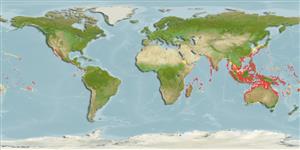Common names from other countries
Environment: milieu / climate zone / depth range / distribution range
Οικολογία
; εύρος βάθους 0 - 60 m (Ref. 348). Tropical
Indo-Pacific: from Mauritius Island and Sri Lanka to eastern Melanesia, north to southern Japan and south to Queensland.
Length at first maturity / Μέγεθος / Βάρος / Age
Maturity: Lm ? range ? - ? cm Max length : 6.5 cm SHH αρσενικό/απροσδιόριστο; (Ref. 348); common length : 4.0 cm SHH αρσενικό/απροσδιόριστο; (Ref. 348)
The shell is commonly used in the shellcraft industry for decorative items (Ref. 348). Maximum depth from Ref. 75831. Found in intertidal areas in sand and mud (Ref. 75831).
Life cycle and mating behavior
Γεννητική Ωρίμανση | Αναπαραγωγή | Γεννοβολία | Αβγά | Γονιμότητα | Προνύμφες
Members of the class Bivalvia are mostly gonochoric, some are protandric hermaphrodites. Life cycle: Embryos develop into free-swimming trocophore larvae, succeeded by the bivalve veliger, resembling a miniature clam.
Poutiers, J.M. 1998. (Ref. 348)
IUCN Red List Status (Ref. 130435)
CITES status (Ref. 108899)
Not Evaluated
Not Evaluated
Threat to humans
Harmless
Human uses
αλιεία: παραδοσιακή αλιεία
| FishSource |
Εργαλεία
Διαδικτυακές πηγές
Estimates based on models
Preferred temperature
(Ref.
115969): 23.7 - 29, mean 28 (based on 1334 cells).
Vulnerability
Low vulnerability (10 of 100).
